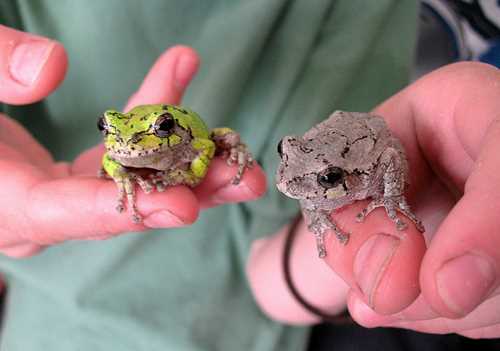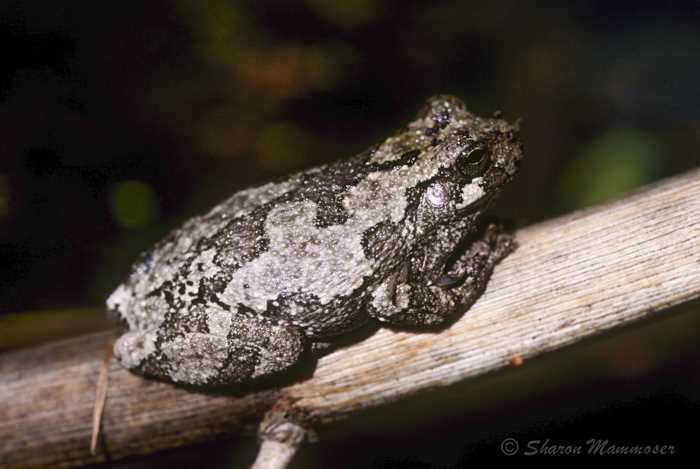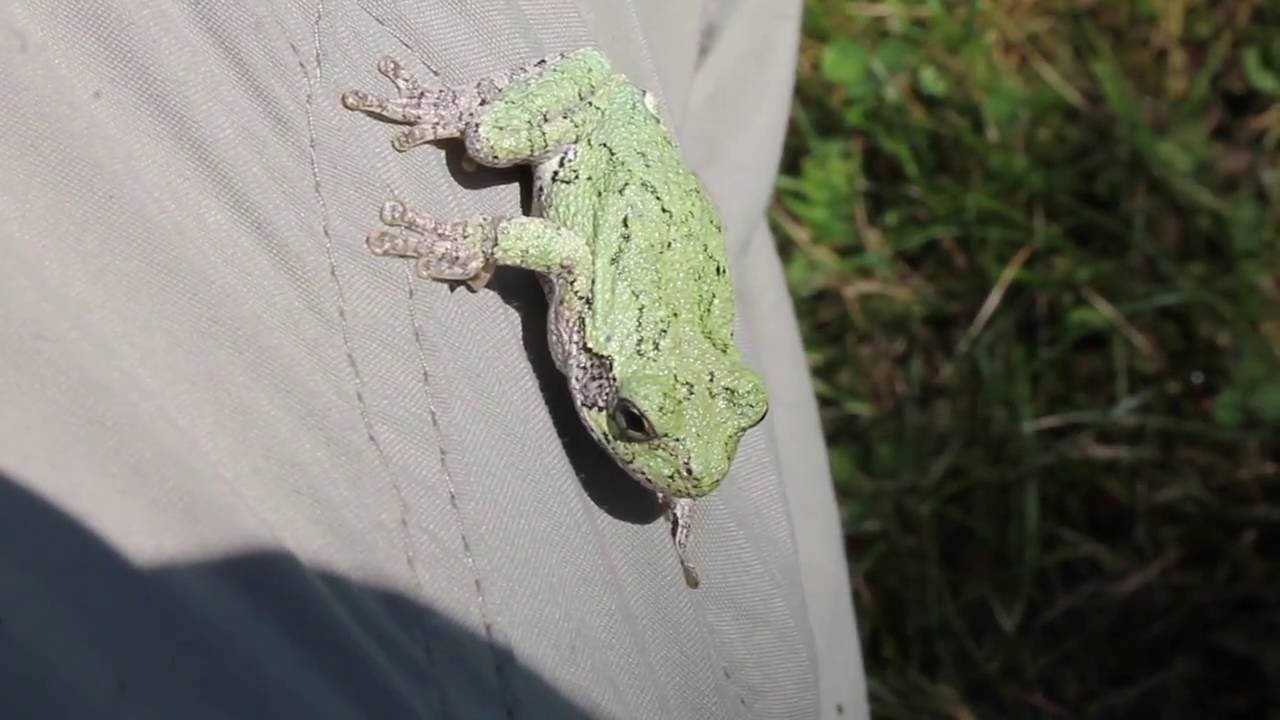
Tree frogs are an astonishing and captivating species of amphibians known for their remarkable ability to change color. This unique characteristic allows them to blend seamlessly into their surroundings, making them masters of camouflage. The process of color change in tree frogs is not only visually stunning, but also serves various important functions in their survival and reproduction.
One of the primary reasons why tree frogs change color is for thermoregulation. These cold-blooded creatures rely on external sources of heat to regulate their body temperature, and their ability to alter their color helps them achieve this. By changing their skin pigmentation, tree frogs can either absorb more sunlight to warm up or reflect light to cool down. This adaptation allows them to effectively adapt to different environmental conditions and maintain their ideal body temperature.
Furthermore, color change in tree frogs plays a crucial role in their communication and mating rituals. During the breeding season, male tree frogs often display vibrant and striking colors in order to attract potential mates. By changing their coloration, they can effectively advertise their health and reproductive fitness to females. Additionally, some species of tree frogs use color change as a means of signaling territorial boundaries or warning off potential predators. This ability not only enhances their chances of successful mating, but also helps them avoid dangerous situations.
Tree Frog Color Change: The Science Behind Their Phenomenal Transformative Abilities
Tree frogs are remarkable creatures known for their incredible ability to change color. This adaptation allows them to blend into their surroundings, whether it be a vibrant leaf or a tree trunk, and provides them with a crucial advantage in their survival. But what is the science behind this phenomenal transformative ability in tree frogs? Let’s dive into the fascinating world of tree frog color change.
The ability of tree frogs to change color is due to specialized and unique cells called chromatophores in their skin. These cells contain pigments that can expand or contract, altering the skin’s coloration. The two main types of chromatophores found in tree frog skin are melanophores and xanthophores. Melanophores contain dark pigments called melanin, which can produce colors ranging from brown to black. Xanthophores, on the other hand, contain yellow pigments called xanthophylls, which can produce colors from pale yellow to bright orange.
The color change in tree frogs is not just a random occurrence; it is a highly regulated process controlled by various factors. One crucial factor is the frog’s environment and the signals it receives from it. When a tree frog is exposed to different light intensities or colors, its chromatophores respond by expanding or contracting, adjusting the color of its skin accordingly. This allows the frog to match its surroundings, providing essential camouflage and protection from predators.
Another factor influencing tree frog color change is temperature. Research has shown that temperature affects the rate at which chromatophores respond and the degree of color change. Generally, higher temperatures result in more intense and rapid color changes, while lower temperatures slow down the process. This temperature-dependent color change mechanism helps tree frogs adapt to their environment and maintain optimal camouflage.
The Role of Camouflage in Tree Frog Survival

One of the most fascinating aspects of tree frogs is their ability to change color, which plays a crucial role in their survival. This remarkable adaptation allows them to blend seamlessly into their environment, providing camouflage and protection from predators.
Adaptation and Camouflage
The ability of tree frogs to change color is an evolutionary adaptation that has developed over millions of years. This adaptation allows them to match the colors and patterns of their surroundings, making them virtually invisible to predators such as birds, snakes, and other animals. The tree frog’s ability to change color is a form of camouflage, which provides them with a distinct advantage in their natural habitat.
Tree frogs have specialized skin cells called chromatophores, which contain pigments that give them their color. These cells can expand and contract, allowing the frog to change its color within a matter of seconds. By adjusting the size and distribution of the pigments in their skin, tree frogs can create a wide range of color variations, including shades of green, brown, yellow, and even gray.
The Importance of Camouflage
The ability to change color is crucial for tree frogs to avoid detection by predators. In the dense foliage of trees and plants, blending in with the surroundings is essential for survival. By adapting their color to match the foliage, tree frogs become virtually invisible to predators, making it difficult for them to be spotted and captured.
Additionally, tree frogs also utilize their ability to change color as a means of communication with other frogs. During breeding season, male frogs change their color to attract females and establish their territory. The vibrant colors and patterns act as signals to potential mates, ensuring successful reproduction.
Survival Strategies
Tree frogs have developed several strategies to maximize their camouflage and survival. They often choose perches that match their coloration, providing them with natural protection. Furthermore, their skin pigments can also react to different lighting conditions, enabling them to adjust their color to match the changing environment.
- Tree frogs may also use their ability to change color as a means of thermal regulation. By adjusting their coloration, they can absorb or reflect sunlight, helping them to maintain optimal body temperature.
- In certain situations, tree frogs may deliberately change their color to deter predators. Some species possess bright warning colors that signal toxicity or distastefulness, warning predators to stay away.
Adaptations and Mechanisms for Changing Color
Physiological Adaptations
One of the main factors responsible for tree frogs’ color-changing ability is their specialized skin cells, called chromatophores. These cells contain pigments that can expand or contract, altering the frog’s appearance. The most common pigments found in tree frogs are melanin, responsible for brown and black colors, and carotenoids, which produce yellow, orange, and red hues.
In addition to chromatophores, tree frogs also have iridophores, which are cells that contain reflecting pigments. These pigments interact with light, giving the frog its vivid and iridescent colors. By manipulating the arrangement of both chromatophores and iridophores, tree frogs can change their color to match their environment.
Environmental Cues
The color-changing process in tree frogs is triggered by various environmental cues. Temperature, humidity, light intensity, and even the presence of predators can all influence the frog’s coloration. For example, in warmer conditions, tree frogs tend to become darker to absorb more heat, while in cooler environments, they become lighter to reflect sunlight and stay cool.
Furthermore, tree frogs can rapidly change their color to blend in with their surroundings and avoid being detected by predators. This ability is crucial for their survival, as it allows them to hide from potential threats and increase their chances of staying undetected.
Neuromuscular Control
Changing color is not a passive process for tree frogs. It requires precise neuromuscular control to regulate the expansion and contraction of chromatophores and iridophores. This control is enabled by specialized nerves and muscles that work in harmony to produce the desired color change.
The neural signals from the frog’s brain stimulate the release of hormones that trigger the expansion or contraction of the pigmented skin cells. This process happens rapidly and can occur within seconds, allowing the frog to adapt to its environment in real-time.
Overall, the ability of tree frogs to change color is a remarkable adaptation that enables them to thrive in their diverse habitats. Through physiological adaptations, environmental cues, and precise neuromuscular control, these creatures can blend seamlessly into their surroundings, ensuring their survival in a world full of potential predators.
Implications for Scientific and Technological Advancements
Frogs have long fascinated scientists and researchers not only for their ability to change color but also for the potential applications of this unique trait in scientific and technological advancements. The study of frog color change has led to significant discoveries and inspired innovations in various fields.
Advancing the Field of Optics

The ability of frogs to change color has provided valuable insights into the field of optics. By studying the mechanisms behind their color-changing abilities, scientists have been able to understand the principles of light interaction and develop new materials and technologies for manipulating light. For example, researchers have been able to create artificial materials that can change color in response to external stimuli, similar to how frogs change color to blend into their environment.
Medical Applications
The adaptive nature of frog color change has also inspired researchers in the field of prosthetics. By studying the mechanisms behind this natural ability, scientists are working towards developing artificial materials that can change color in response to external stimuli. This could potentially lead to advancements in prosthetic limbs that can replicate natural color-changing abilities and better integrate with the wearer’s surrounding environment.
Environmental Monitoring
Another potential application of studying frog color change is in environmental monitoring. The ability of frogs to change color in response to environmental factors such as temperature and humidity could be harnessed to create sensors that can detect and monitor changes in the environment. These sensors could be used to monitor water quality, climate patterns, and other environmental indicators, providing valuable data for conservation and resource management efforts.

I’m Lena Adams—a product of an unconventional upbringing in the African wilderness. My father, a daring explorer of African wildlife, sparked my fascination with reptiles, a passion that intertwined with the tragic loss of my mother during an expedition, leaving an indelible mark on my life. Driven to understand the creatures that captivated my parents, I embarked on my journey, sharing insights about reptiles, frogs, and lizards on my website. Through my explorations and conservation efforts, I honour my family’s legacy while seeking connections—to the creatures, nature, and the mother whose presence I yearn to understand.
